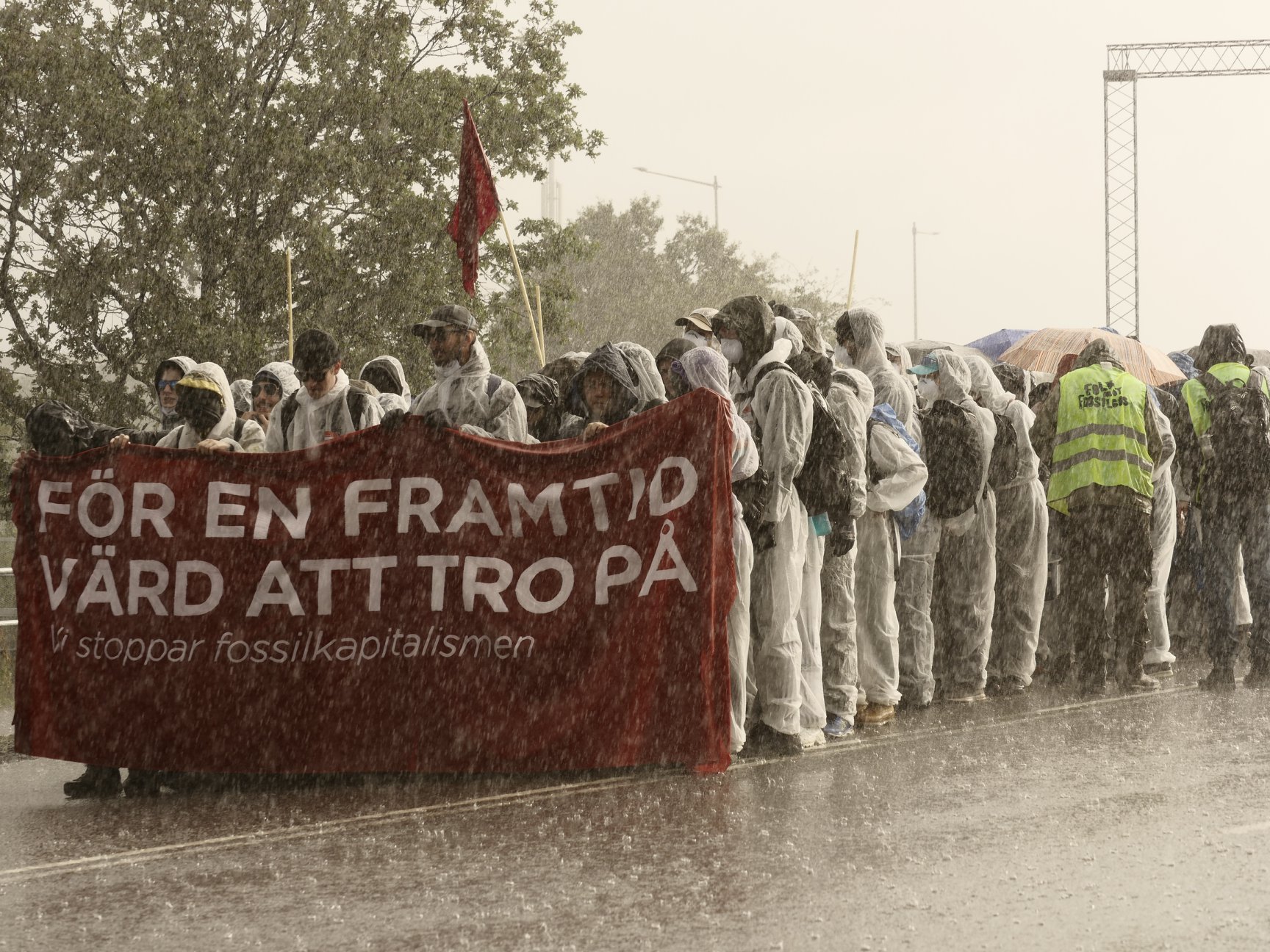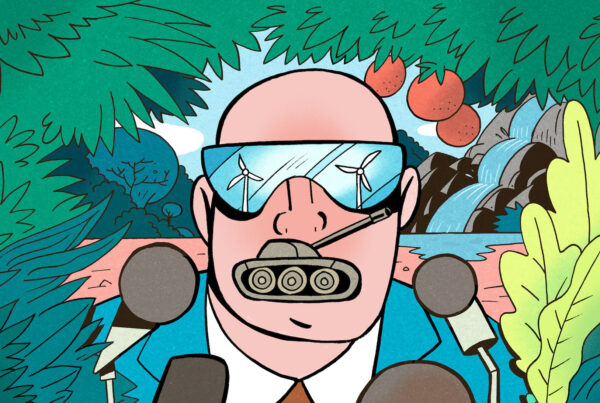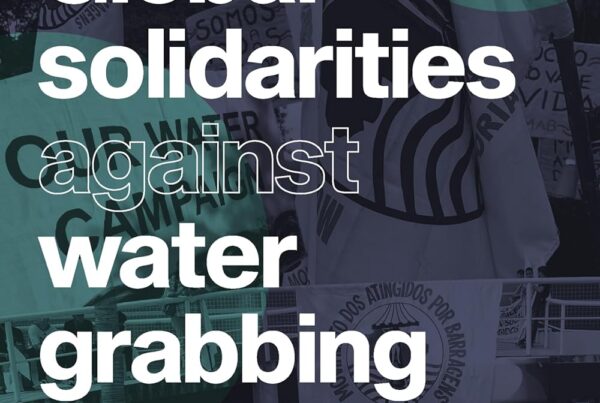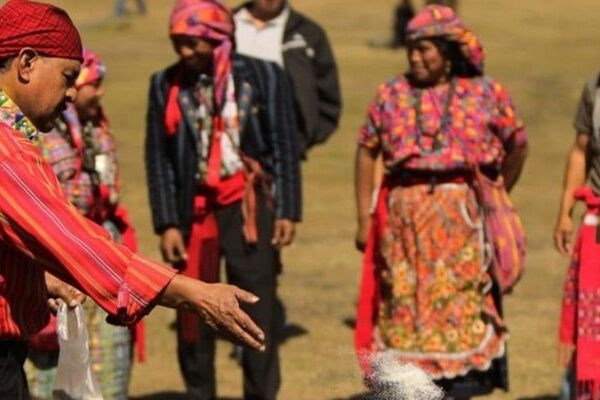By Salvatore De Rosa
How does it feel to take part in a direct action to stop climate chaos? What do you need to know and what do you learn before, during and after? Here we offer a reportage and some reflections on the mass action at the port of Göteborg, Sweden, on September 7th, 2019. While we block the flows, we build the communities able to face these troubled times.
I found them the way potential allies find each other nowadays, on social networks. I was following climate movements in Europe organizing against the political inertia in facing the climate crisis. Both for research and for personal concern. I found many, different, and with heterogeneous aims, at times rooted in local grassroots networks and always linked internationally, proliferating during the last year. Living between Denmark and Sweden, and searching for direct action movements, I decided to join Folk mot Fossilgas (people against fossil gas), a coalition of political and grassroots organisations mobilising against the fossil economy. As the German-based coalition of Ende Gelände, their strategy is to intervene on symbolic and resource-intensive key nodes of the system of production and distribution of fossil fuels to block the flows. One of the aims is to debunk the widely held (read: carefully engineered) view that gas is a cleaner and greener choice than oil or coal. Their lobbying activity in Sweden targets the government and the media, but they know too well that appeals and information campaigns are not enough to stir action towards the decarbonisation of the economy, and that it is imperative to increase the pressure from below in order to impose the transition away from fossil fueled-capitalism. An ambitious goal, to achieve by pushing for the generalisation of revolt against the status quo, that is fusing a struggle for survival with claims of justice as old as the social conflict, but declined within a novel scenario that brings to the extreme all the inequalities from the past. The climate breakdown as ultimate limit and as opportunity of recomposition, which contains and expresses with renovated urgency all other emancipatory struggles.
Arrival
I marked on the agenda the days from September 6th to 8th. Destination: Göteborg, to the climate camp organised by Folk Mot Fossilgas as a base for the first action in Europe, on Saturday 7th, against a port terminal of LNG, liquefied natural gas, or more correctly, fossil gas. At Göteborg’s port, the multinational energy corporation Swedegas planned to expand the storage capacity for gas coming with tankers across the Atlantic, and to connect the port silos to the land distribution network via pipelines. A mechanism that would lock-in the dependency of the Scandinavian country for at least forty years on the supply of an energy source that is particularly effective in increasing global warming in the short term, and in contradiction with local emission-reduction targets (lessen by 40% within the next year and net zero by 2045). Yet another iteration of the hypocrisy of climate commitments by Western states, where ambitious targets are announced while at the same time authorizations for continuing business as usual are approved. In this context, Folk mot Fossilgas wants to be the grain of sand that jams the gear and makes its contradictions burst.
I arrive alone at the climate camp, in a rainy Friday afternoon. About two hundred people are crowded in the large circus tent built for the occasion; the welcome plenary has just begun. We are in a meadow on the outskirts of Göteborg, half a kilometre from the port. In addition to the tent for the assemblies, there are five other smaller self-built structures that house the info point, the area to eat meals, the media centre, the legal support and the physical and psychological health support. Next to the seashore, about a hundred camping tents are distributed in rows arranged in large rectangles. At the plenary, I meet Andreas, a fellow Swedish researcher on renewable energy and degrowth. Fortunately, he has a place in the tent for me. He is here because he is tired of the gap between research and concrete policies. Knowing a lot about the current situation becomes a depressing exercise when you realise the poor progresses in thirty and more years of awareness of the problem, conscious that even a tenth of degree of avoided heating has calculable effects in terms of human lives saved. We are listening to the program of the day. I won’t miss the coordinated action training in an hour, and I have to find my affinity group in the evening assembly dedicated to forming teams.
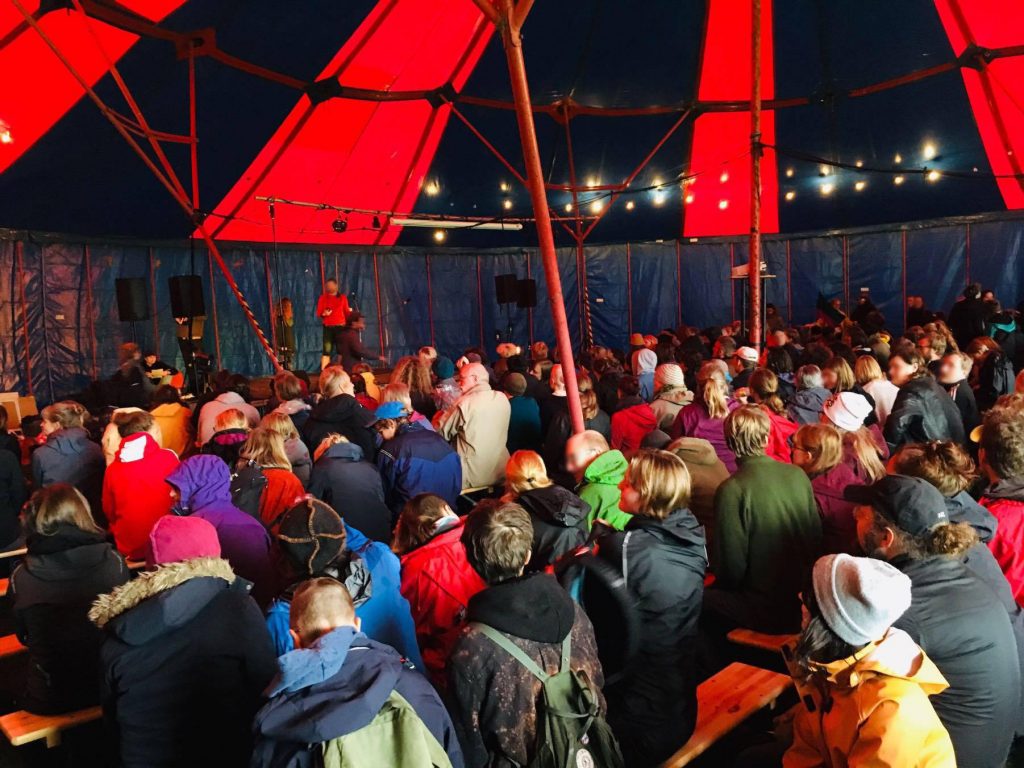
Coordinated mass action
The method of the coordinated mass action utilised by Folk mot Fossilgas is a distinctive tool of the militant climate movements consolidating in Europe. Essentially, it is a mass intervention in a specific site – usually, a physical infrastructure implicated in the fossil economy – with the aim of slowing it down or blocking it altogether. It is presented as the extrema ratio left to people to shake the passivity of decision makers by challenging directly the extraction, movement and use of coal, gas and oil. As a radical political technique, it builds on the German anti-nuclear movement between the seventies and nineties, when the trains carrying nuclear waste and turbines were blocked. Other elements have been added during the last ten years of climate camps, especially in the United Kingdom, in particular the formation of small affinity groups to contain the risk of police infiltration and to enhance coordination. For the same reason, the actual course of the action is secretly developed by local promoters and manifested only during the action itself. The elaboration of the plan involves knowledge of the context and a detailed program to establish paths, prepare manoeuvres of encirclement, and manage the different roles of a tide of bodies. A canvas that then the fingers and the affinity groups develop independently. This implies knowledge of the local topography, the site security systems, the work shifts and the operating hours. The objective is not really a sabotage, as the action is announced and widely publicised. Rather, it is a demonstration of grassroots force in rejecting certain processes, which aims to the maximum visibility and to the construction of imaginaries of revolt that inspire emulation.
Being an act that defies the law, by invading private property or occupying public places, the risk of being arrested is an integral part of it. Collective security is guaranteed by the high number of participants: the denser and bigger the mass, the more it hides the individuals and shows their unity, also thanks to the white suits. To take part in the action, one must accept the restrictions and purposes presented in an informed consent document. However, the actual degree of risk that one decides to take is at personal discretion, and is reflected in the roles and positions of the affinity group one joins. Violent attack and provocation are banned, but other forms of illegality connected to the success of the action, and carried out in group, are considered legitimate. A complex series of organisational principles and communication codes – which must be learned in dedicated training sessions – allow to deal with highly dynamic actions in a coordinated manner, responding quickly to changing conditions.
The peculiar obsession with forms of dialogue that enhance horizontal decision-making, before and during the action, not only responds to the refusal of authoritarianism but also to the attempt of “erasing” the leaders from the picture, thus avoiding that certain subjects more exposed become visible to repression. The myriad of micro-techniques that safeguard collective consensual action owe to the political awareness of militant feminism. Starting from the concentric structure – which has buddies at its core, integrated in affinity groups, then in action fingers with different roles, in turn collected in the totality of the “mass” – up to the sign language and the facilitation techniques that lead the discussions, without neglecting spaces dedicated to the expression of individual emotions and self-criticism. Overall, a set of practices rooted in the tradition of civil disobedience but declined in new forms, more mature and adapted to the times. When it goes well, the result is the collective construction of a highly symbolic event, visible and easily understandable to the outside, inviting and safe for the neophytes of activism, culminating in a formative and transformative experience for the individual participants. The ductility and power of coordinated mass action is demonstrated by the proliferation of groups that use it. Like Ende Gelände, the contemporary champions of this method, not by chance Germans, or the Gastivists, a global network of anti-fossil fuel activists whose members travel far and wide to spread it, and Extinction Rebellion, for which this method has acquired a fundamental role in urban actions aimed at blocking city centres, parliaments and the headquarters of multinational energy companies.
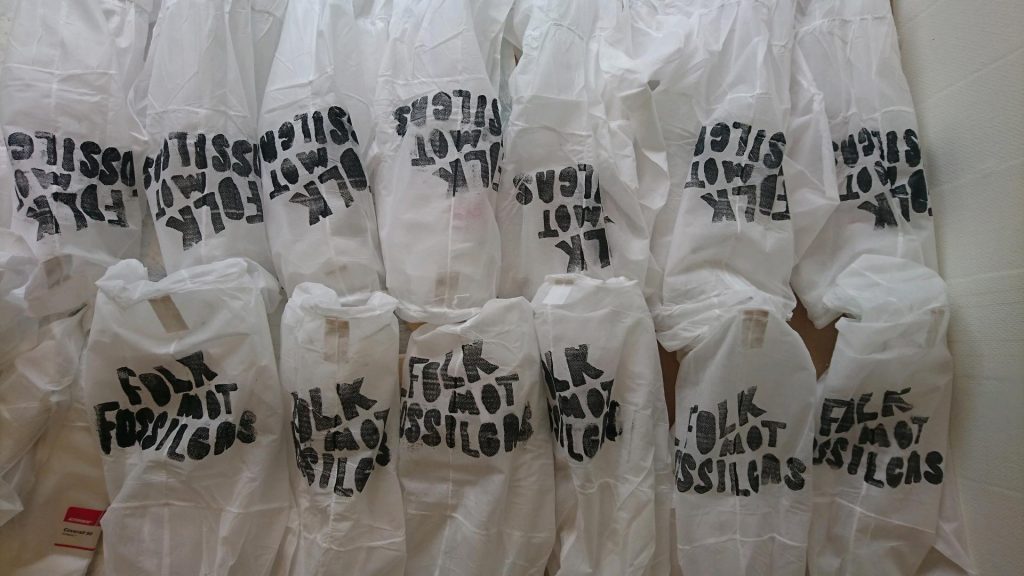
The camp
Strolling around the camp while waiting for the training, I meet a young Dutch anarchist two meters tall. He has participated in dozens of riots at the G8 summits and lives in a squat in Rotterdam. He came without documents and says that certainly he will not be arrested, a possibility that many instead take into account. He states that “he cannot afford it”, yet he is ready to attempt a blitz in the harbour with his affinity group. A good reason not to choose him as a buddy, since I intend to return to my little son after the action. The atmosphere in the camp is relaxed, festive, I almost forget that we are setting up a siege. The organisation is based on voluntary work, and I sign my name at the info point among the dishwashers. The practical tasks to keep the community life going – like cooking, cleaning, assembling and disassembling, and much more – are taken very seriously by volunteers. I feel like in an anarchist commune that has given itself a military discipline without hierarchies and orders; alcohol and drugs are banned but music fills the air. Meanwhile, people keep coming. The average age is under thirty, but there is no shortage of white-haired militants with many environmental and social battles behind them. There are fragments of hippie culture, yoga asana and bare feet, and a marked presence of austere activists in technical clothes suitable for climbing or arctic explorations.
The overwhelming majority is European and white, so I am intrigued by a middle-aged man with brown skin and a long braid. Indeed he is an American Indian, his name is Christopher, an Esto’k Gna from the tribe of Carrizo Comecrudo, settled in the valley of the Rio Grande in Texas. He is part of the international delegation against fossil gas, which has representatives from the Irish, English and Argentinian movements. Alongside the reservation where he lives, have recently been approved three different shale gas extraction sites through fracking, a technique that causes earthquakes and pollutes groundwater. That is the gas that arrives in European terminals like the one in Göteborg. For Christopher, fighting the extraction and trade of fossil fuels is just the continuation of the anti-colonial struggle of Indigenous peoples against a process of exploitation and genocide that began in 1492. He is pleased that the European children of colonialism have finally woken up, now that their world is collapsing too. I reach the tent where the training is about to begin. There have been dozens of training in different north-European cities during the previous weeks, but I lost them. Now it is the last chance to prepare for the action and, like me, about fifty bystanders are waiting.
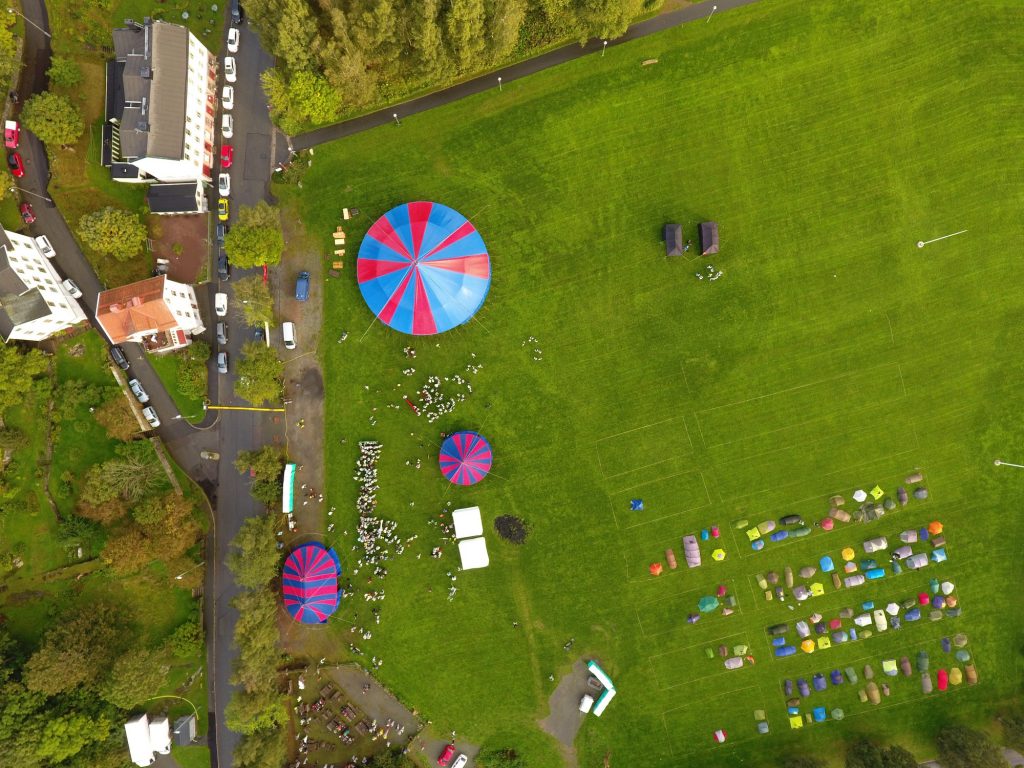
The training
We start by forming temporary buddies’ pairs and affinity groups. The pair of buddies is the basic unit of the mass. Thanks to the buddy, everyone will have someone who cares about her physical and mental state during the action, checks where she is and supports her when the rhythm becomes hectic. The buddies are in turn collected in affinity groups from a minimum of four to a maximum of twelve people. The group moves together and remains united. It makes decisions about the involvement and the risk it wants to take, and sends a rotating delegate to the micro-assemblies during the action to decide what to do. Having a representative allows to make the debate faster, considering that ten or twelve people can discuss on behalf of around a hundred people. Every time a decision has to be made, the delegate goes back and forth between the meeting and her group, collects the will of the comrades, arrives at a consensual position and eventually the roles and tasks are redistributed. It seems difficult to coordinate at first sight, but I note in the exercises of potential scenarios that the method works without too many frictions. A series of techniques are imparted to us to speed up the debate: the movement of the hands at different heights to signal consent, doubt or rejection; the assignment to the most temperate in the group of the role of instant decision maker when there is no time to discuss; the veto sign with arms crossed when someone thinks that the idea just proposed is madness and therefore invites everyone to reconsider.
Then, we start the training on the confrontation with the police. In this action, we will just attempt to block the four entrances of the gas terminal to stop the traffic of tank trucks, without invading the port, so we must be ready to carry out blocks with our bodies that the police will eventually take care of removing. For those who feel like it, the mandate is not to voluntarily abandon the position and to respond to invitations from Swedish cops with silence or singing, keeping the arms intertwined with the neighbour. We are shown different positions for being removed without getting injured, and we mime the eviction in a sort of game with quite serious implications. The Swedish police can hold you for up to twenty-four hours if you resist orders, and even more if you don’t show your ID or if there are clues of other crimes. Tonight’s training lasts an hour, it is a diluted and essential version, in other cases it can last between one and three days.
Eventually, through a role-play game based on questions around individual preferences, I come to stand alongside those who will form my affinity group. We are six. There is Hanna, a 20-year-old Swedish student, frustrated by the fact that friends and family do not take her climate concerns seriously. Jonas and Clara, a psychologist and an educator that, in addition to being vegetarians and recycle trash, want to act. Then Axel, an artist who lives in a former abandoned factory in Malmö and that will make us laugh a lot during the blockade, and finally Andreas and me. We are a moderate affinity group, we will go on until the end but will avoid being arrested. We eat a vegan dinner together in the communal kitchen. Now there are about four hundred people in the camp, but everyone can have a second portion. There is not even the shadow of disposable cutlery or glasses: half of the people brought the mess-tin from home, for the other half there are cutlery and bowls that will then be cleaned by dishwashers like me.
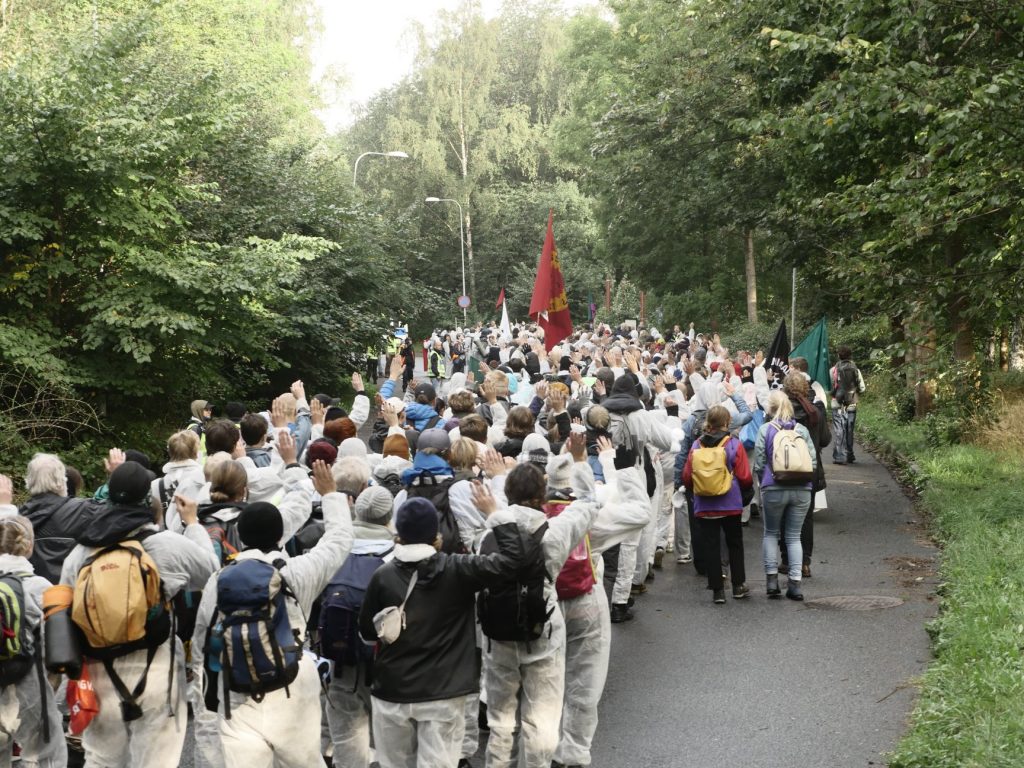
The action
At quarter past six on Saturday morning the alarm group goes around the tents with a megaphone. By eight we leave. The night was damp, the rain did not stop for a minute, and now, as I emerge stunned from the tent, it has become a mist of water particles that gets to the bones. Without too much fuss, after having consumed the Scandinavian breakfast of oatmeal and fruit in syrup, we prepare ourselves in rows of six, all wrapped in the white suits of fine fabric over our clothes. It looks like the classic demonstration, but more orderly and with a precise mission. In the path between the camp and the port, the rain increases. I look at the others in my group with a little discouragement, but I seem to be the only one upset by the water. In the north, it is said that there are no adverse weather conditions, only unsuitable clothes. Good thing I have good shoes then.
Halfway, the fingers divide towards the various gates of the terminal, among incitement cries and bengal fumes. My finger arrives in front of the main entrance, a long electrified gate behind which silos and cranes of the port stand out. We conquer the space in a blink of an eye. The group of about twenty policemen stationed on the pavement stands still. On both sides of the gate, a row of tank trucks that ran unimpeded is now blocked, and the drivers swear or smoke nervously. Along the way, and even now, a couple of drones are buzzing around for video filming by the organisers of the action. At least two other people take photos and videos non-stop and will continue until evening. This emerging climate movement seems to me to be all too aware of the importance of images in the current world of communication, and participates in it by exploiting all its channels and tools. It is true that the autonomous diffusion of what we are doing is fundamental for the purposes of the movement. After all, the stated objective is the attempt to influence the narrative on the legitimate practices of climate resistance, and to present this type of actions as exciting and effective. But I can’t shake off the feeling at certain moments of being a figure in a script written elsewhere by a handful of people, of being used to set up a counter-spectacle in which the image becomes more important than the result on the ground. There is not enough time now to think about it, we are in trepidation to understand the moves of the police.
Two of ours in yellow gilets have the role of communicating with the police. After a brief exchange, the ‘human microphone’ is used (a technique borrowed from Occupy Wall Street, in which those at ear distance repeat together and aloud the sentences of those who speak so as to get the message to those more distant) to spread the news that the police will not remove us. The tension disappears, it even stops raining and quite incredibly a summer sun pierces the clouds and dries the water-covered suits. The same news arrives from the other blocks: everything is running smoothly, the terminal is blocked, the trucks do not enter or leave, the police merely observes, and the morale is high. Several televisions carry out interviews and picture the block in all its static beauty. We will end up in the lunchtime news of the major Swedish media, and we will be able to boast about the fact that instead of “natural gas”, as the companies that sell it like to call it, they are talking about “fossil gas”.
Hours go by and the situation is the same. It’s becoming a picnic on the concrete, someone has even brought musical instruments and circus games. We sleep and eat, the most serene block I’ve ever done. In Campania, when we were struggling against landfills and toxic waste, this was certainly not the case, but I realise that the current institutional and corporate responses are also part of a strategy. Swedegas, the multinational corporation that owns the terminal, does not want to put itself against a Swedish public opinion more and more concerned by climate change, preferring to let it pass, maybe lose a few profit margins for a day, and keep a low profile. For its part, the Swedish state, the home of Greta and the environment as a shared cultural value, probably does not want to be recorded while it hurts peaceful ecologists in white suits. And so we all agree, they let us play for a day in the battle for a better world and tomorrow we return to normal. In reality, transforming these actions into permanent blockades is one of the horizons of the movement, but this would require a participation and a logistical organisation for now out of reach. But the foundations are being built. At noon, the food brigade arrives to feed us with the usual vegetarian meal and the brown rice on cargo bikes. They also have coffee and sweets. They will go to all the gates and come back for dinner. The program is to stay at least twelve hours, we will have to kill time and in fact by the evening I will have made myself quite a few friends.
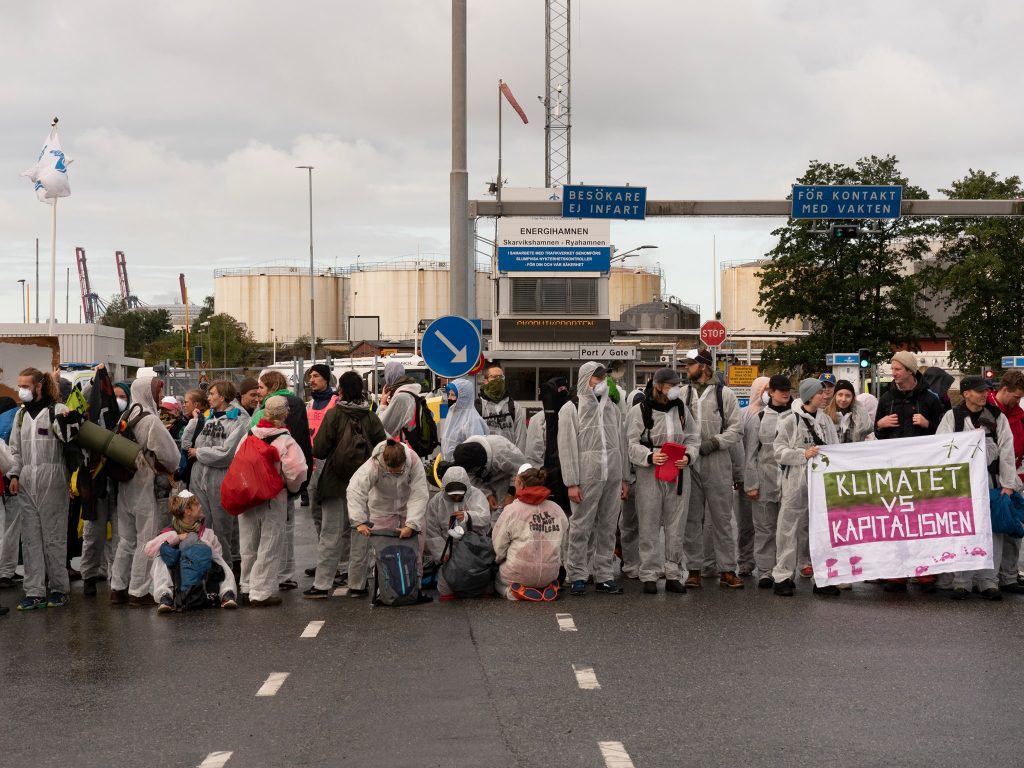
Reflections
The sun has set, it is starting to get cold. There was a peak of enthusiasm at the arrival in the afternoon of about two hundred people of families and supporters from the city centre, together with a truck blasting disco music and making everybody dance for two hours, but now that they left we are immersed in torpor, aching legs and boredom. During a couple of meetings of the delegates the consensus is reached to continue the blockade until late night, but those who want to return to the camp are free to do so. No one leaves. Word arrives that an affinity group has penetrated autonomously into the port to spread a banner from one of the silos; they were caught and taken out without consequences. I spend some time discussing with the legal team in purple gilets about the movement’s response to any arrests. It seems there is not enough strength at the moment to pay legal fees, but there are friendly lawyers and a support campaign to be activated when needed. We won’t need it this time. I’m destroyed; humidity and fatigue are all that I feel, but Axel’s jokes keep me up while an American guy is playing blues on the guitar with random words about the pipelines.
Only yesterday, we were strangers united by something elusive, a tension, an anger, a desire, maybe similar resolutions starting from very different personal stories. Now, we call each other by name, or by pseudonym, we exchange everything and we move coordinated like an anthill. We are a temporary community built on the rubble of the future to change its trajectory, or at least that’s what we tell ourselves. We are those vegetarians who do not take planes and dig in the dumpsters of supermarkets to recover good food, those for which the normality of our cities is not so normal anymore. But we do not play the trumpets of apocalypse and we don’t go to isolate ourselves in ecovillages on the mountains. I speak of “we” but I wonder if this is not just the result of a fantasy stunned by too many hours sitting on the concrete. I felt a similar brotherhood and sisterhood in the much more confused and violent actions of the waste wars in Campania, but back there we all came from the same towns, close to each other, we identified with the earth, air and water of a specific bioregion under attack.
Here, we use a foreign language to communicate, we have no common relatives and we struggle to empathise with the troubles of the respective contexts. Yet, we recognise ourselves. Perhaps, it resists something of the spirit of the social forums that have taken place from Porto Alegre up to the crash of Genoa, between the nineties and the zeroes, something similar to that sense of solidarity given by finding oneself in a battlefield coinciding with the planet. Certainly, these actions build on the networks of the climate justice movement, which in turn is rooted in hundreds of local environmental conflicts. With important additions: the need to find plausible medium-term goals; the focus on training and preparation but remaining inclusive; the attempt to deconstruct the dynamics of power within groups; the awareness of the necessary work on social imaginaries and the coherence between goals and common life practices. The stroke of genius has been to shift the attention and action from the climatic summits of the elite in urban centres to the concrete places that reproduce destruction, scattered in the interstices of the landscape. Although the declared objective is to force governments to act, in practice we do the dirty work of blocking the flows. And succeeding is extremely satisfying.
Victory
About a month after the action, the Swedish government has announced that it denied Swedegas the final permit for expanding the terminal and connect it to the land network. Also, other expansion and construction plans in several Swedish ports have been halted. Does this mean that climate direct action works? Of course it does. And not just that: while we block, we build the communities and the practices of the future, those that will help smashing the system and facing the outcomes of climate breakdown.
All photos are courtesy of Folk mot Fossilgas. A version of this reportage in Italian has appeared on Issue n.3 of Lo Stato delle Cittá, a magazine published by Napoli Monitor. Research for this blog post has been funded by FORMAS (Swedish Research Council for Sustainable Development) under the National Research Programme on Climate (Contract: 2017-01962_3).


